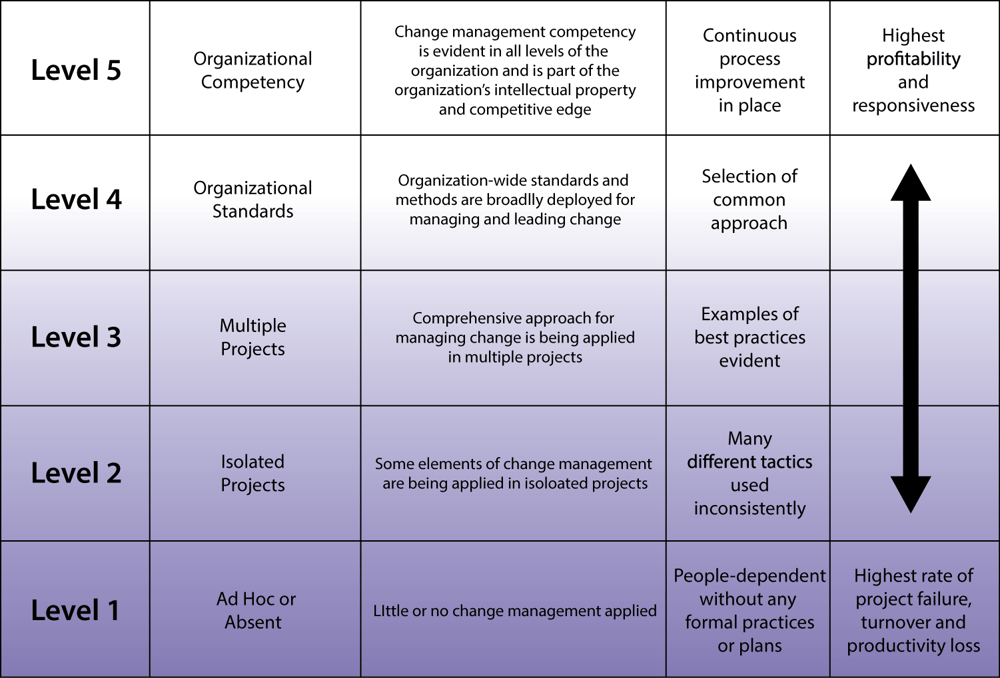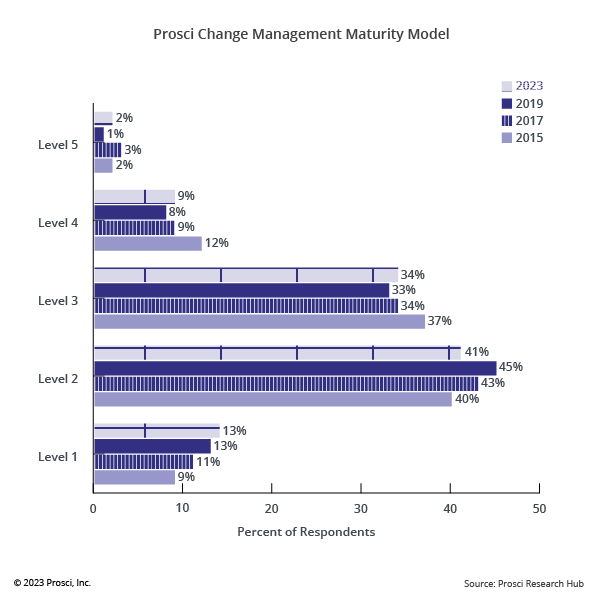5 Levels of Change Management Maturity

6 Mins
Updated: March 10, 2024
Published: March 4, 2022

Organizations are facing larger and more frequent changes in the current economic climate. A changing marketplace, empowered workforce and technological advancements have created an environment where change is now a part of everyday business. In this environment, organizations are beginning to recognize the importance of building the competency to rapidly and successfully change.
Prosci’s Change Management Maturity Model, based on benchmarking research, describes the varying levels of change management capabilities across organizations. The maturity model has five levels, ranging from no change management to organizational competency. Each level involves more attention and management of the people side of change.

Below is a detailed explanation of each level as well as the action steps your organization can take to move to the next level of the model. The article concludes with research data on Maturity Model levels from Prosci's Best Practices in Change Management – 11th Edition.
Prosci Advisory Services
Get guidance and hands-on support with your projects and initiatives when you partner with Prosci.
Level 1: Ad Hoc or Absent Change Management
At Level 1 of the organizational change management maturity model, project teams are not aware of change management and do not consider it as a formal approach for managing the people side of change.
Use at the Project Level: Change management is applied on a project only as a last resort when employee resistance jeopardizes the success of the project.
Level 1 integration between project management and change management
Change management is reactive and an add-on to the project. No integration with project management takes place at the beginning of the project.
Projects at this level can have one or more of the following characteristics:
- Project leadership is focused only on the technical side of the project including funding, schedule, issue tracking and resource management
- Communications from the project are infrequent and delivered on a need-to-know basis
- Employees find out about the change first through rumors and gossip rather than structured presentations
- Executive support is only evident through funding authorization and resource allocation; there is no active and visible sponsorship
- People managers have little or no information about the change and have no change management skills to coach their employees through the change process
- Employees react to change with surprise and can be very resistant
- Productivity slows and turnover increases as the change nears full implementation
Steps for moving to Level 2
- Attend change management training, purchase change management tools and resources, or engage change management consultants
- Apply change management to isolated projects and use change management techniques to help projects that are currently experiencing resistance to change
Level 2: Change Management on Isolated Projects
In Level 2, elements of change management begin to emerge in isolated parts of the organization. The effort to manage the people side of change is infrequent and is not centralized.
Characteristics of this level are:
- A large variation of change management practices exists between projects with many different change management approaches applied sporadically throughout the organization; some projects may be effectively managing change while others are still in Level 1
- There are elements of communication planning, but there is little sponsorship or coaching
- People managers have no formal change management training to coach their employees through the change process
- Change management is typically used in response to a negative event
- Little interaction occurs between the isolated project teams using change management; each new project “re-learns” the basic change management skills
Level 2 change management and project management integration
In Level 2, projects apply change management when resistance emerges or when the project nears implementation. Only isolated projects use change management at the beginning of their project. Some elements of communication planning occur early in the lifecycle.
At this stage, change management is not fully integrated into project management. On projects that use change management, the project team is aware and knowledgeable of change management. In certain instances, a change management advocate can encourage the integration of change management and project management.
Steps for moving to Level 3 maturity
- Create knowledge about the different change management initiatives used in the organization and begin research in change management best practices
- Create clusters of project teams applying change management principles
- Begin collection of knowledge and tools across the organization and celebrate change management successes
- Begin building support for using change management with executives and senior leaders who oversee multiple projects

Level 3: Change Management on Multiple Projects
At Level 3, groups emerge that begin using a structured change management process. Change management is still localized to particular teams or areas in the organization.
Organizations at this level can have one or more of the following characteristics:
- Multiple projects are using structured change management processes, although these approaches and methodologies may be different
- Some elements of knowledge sharing emerge between teams in the organization; teams in some departments are sharing experiences and lessons learned
- While change management is applied more frequently, no organizational standards or requirements exist; pockets of excellence in change management co-exist with projects that use no change management
- Senior leadership takes on a more active role in sponsoring change and consider this role part of their responsibilities, but no formal company-wide program exists to train project leaders, people managers or coaches on change management
- Training and tools become available to project leaders and team members; people managers now have the training and tools to coach frontline employees
Level 3 project management and change management integration
Change management is initiated at the start of some projects, with a large fraction still applying change management as a reaction to employee resistance during implementation.
Teams who are successful at change management integrate change management with their overall project management methodology at the inception of the project, including communication and other change management plans.
Steps for moving to Level 4 maturity
- Enlist executive support for applying change management on every project and for building change competencies at every level in the organization
- Select a common methodology that can be used throughout the organization and begin acquiring the tools and training necessary to roll out the common methodology
Level 4: Organizational Change Management Standards
In Level 4 of the Change Management Maturity Model, the organization has selected a common approach and implemented standards for using change management on every new project or change. Note: a common methodology does not mean a one-size-fits-all recipe; effective methodologies use repeatable steps, but they work best when tailored to the specific needs of every project.
Organizations at this level can have one or more of the following characteristics:
- There is an enterprise-wide acknowledgement of what change management is and why it is important to project success
- They have selected a common change management methodology and are developing plans for introducing the methodology into the organization
- Executives, project teams and change leaders have access to training and tools, and people managers have formal training on their roles in change management
- There are individuals, groups or administrative positions dedicated to supporting change management efforts and building change management skills
- Executives assume the role of change sponsors on every new project and are active and visible sponsors of change
- Teams expect resistance and non-compliance in isolated instances, although some project teams may still not understand why they are using change management
- Adoption is not yet at 100% and the organization is in the process of building change management skills throughout the organization
Level 4 project management and change management integration
At Level 4, teams regularly use a change management approach from the beginning of their project, with change management work included in the planning phase of the project.
As the project progresses, project management and change management continue to integrate to the point where they are not separable. Project teams follow both project and change management milestones.
Steps for moving to Level 5
- Create a formal position or staff group that is responsible for the effective deployment, training and improvement of change management competencies
- Correct non-compliance and analyze gaps in the organization that are not applying the selected methodology
Level 5: Organizational Competency
In Level 5 change management maturity, change management competency is part of the skill set of the organization.
Organizations at this level can have one or more of the following characteristics:
- Effective management of change is an explicitly stated strategic goal, and executives have made this a priority
- Employees across the enterprise understand change management, why it is important to project success, and how they play a role in making change successful
- Change management is second nature, so commonplace that it is nearly inseparable from initiatives
- People managers routinely use change management techniques to help support a broad range of initiatives, from strategy changes to individual employee improvement
- The organization gathers data to enable continuous improvements to the common change management methodology, tools and training
- Extensive training exists at all levels of the organization
- Higher ROI, lower productivity loss and less employee resistance to change across the organization
Level 5 project management and change management integration
When organizations have developed a high level of change management competency, change management steps are completely integrated into project management, and change management work begins before the project kicks off. Planning and design phases have both project and change management elements and are viewed as standard practice.
Change Management Maturity Model Benchmarking Research
In Prosci's Best Practices research, participants identified where they were on the Change Management Maturity Model. Over half of participants (54%) fell at Level 1 (ad hoc or absent change management) or Level 2 (change management on isolated projects). Only 11% were at Level 4 or Level 5, where the organization had truly begun adopting organizational standards and building organizational competencies.

Next Steps to Reach Organizational Change Management Maturity
Moving up the Change Management Maturity Model improves how an organization operates and performs during times of change. There is a growing body of knowledge that shows a direct correlation between how well an organization manages the people side of change and how successful projects and initiatives ultimately are. As an organization sees examples of failed changes due to poorly managed change and successes due to effectively managed change, there is a greater sense of urgency related to moving up the Maturity Model.


